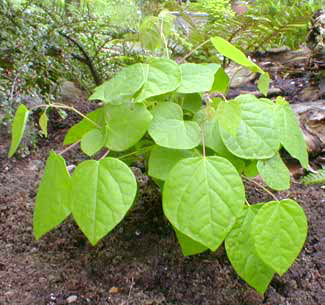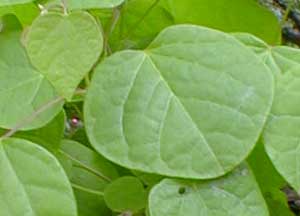
Redbud Hazel
"Autumn is a second spring when every leaf is a flower."
-Albert Camus
(1913-1960)
(1913-1960)
When Granny Artemis & I saw this baby shrub in the nursery, we thought it much too small & bushy to be a katsura tree, but the leaves were so similar. And as it turned out, the species name cerdifolius alludes to its resemblance to katsura (Cercidyphillum) & to a flower resemblance to Redbud (Cercis). For the leaves alone it was extremely appealing.
Common names for Disanthus cerdifolius are Redbud Hazel or Japanese Red Witchhazel. This native of Nagano & Gifu prefectures in Japan is the only species for its genus. Its needs are not dissimilar to witchhazel to which it is related, or it can be grown amidst shade-loving varieties of rhododendrons.
Though slow growing, Redbud Hazel can eventually reach ten or even fifteen feet tall, & even wider. It'll be a small shrub for quite a long while, but in time it needs room to spread out, so cannot be crowded. Ours has ferns & shade perennials nearby that may in time need to be transplanted when the shrub matures.
 The roundish heart-shaped veined leaves are glossy & glaucus blue-green spring & summer, smallish in spring but maturing to four inches. Late in August it begins to pass through a splendid array of colors, starting with deep shades of burgundy, aging with more gold, & concluding as bright red.
The roundish heart-shaped veined leaves are glossy & glaucus blue-green spring & summer, smallish in spring but maturing to four inches. Late in August it begins to pass through a splendid array of colors, starting with deep shades of burgundy, aging with more gold, & concluding as bright red.The color changes continue into October, but can occur at different speeds from branch to branch, so that the shrub overall will be multicolored, & at its peak of glory in October. It is quite likely without equal among shade-shrubs for autumn color.
This large shrub or small tree flowers just before leaf-fall, in October & November, purply-red flowers somewhat similar to Witchhazel blooms, but smaller & not very showy while big red autumn leaves remain an overwhelming present.
The blooms are more like twisty starfish than spidery witchhazel straps, & very interesting blooms considering the time of year, becoming more visible after leaf-fall. The flowers have a faint rather medicinal aroma. The fruits are tinier versions of boxy witchhazel nuts.
In Japan it is called Benimansaku which means "Red First-Flower." A dam's reservoir in Japan's Ono Nature Observation Park is called Lake Benimansaku after this plant. The lake is a place of October pilgrimages so that people see these shrubs in their autumn colors.
It wants bright shade or dappled sunlight or morning sun only. Moist, well-draining, organically rich acidic soil is best. It is adverse to alkalinity & might be harmed if placed near often limed lawns.
It should not experience droughtiness in summer, nor harsh winds in winter, but is otherwise a low-maintenance shrub, rarely troubled by insects or disease, & requiring little or no pruning. It's ideal for our Puget Sound weather (Zone 8) but may be widely adaptable down to Zone 5.
A relatively recent offering in the nursery trade, it was for a long time quite rare, but has begun to get the attention it deserves along with wider distribution, having received the Royal Horticultural Society's Award of Garden Merit in 2004.